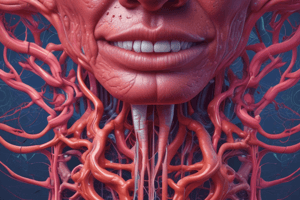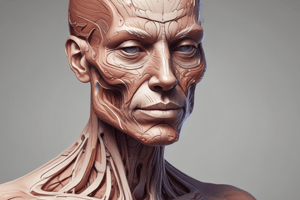Podcast
Questions and Answers
Which of the following is NOT an accessory structure of the skin?
Which of the following is NOT an accessory structure of the skin?
- Muscles (correct)
- Glands
- Hair
- Nails
What is the function of the skin?
What is the function of the skin?
- To sense changes in the environment
- To support the removal of wastes
- To regulate body temperature (correct)
- To produce vitamin D
What is the pH of the skin?
What is the pH of the skin?
- Alkaline
- Basic
- Acidic (correct)
- Neutral
Which layer of the skin is responsible for energy storage and physical protection?
Which layer of the skin is responsible for energy storage and physical protection?
What is the largest organ in the human body?
What is the largest organ in the human body?
Which region of the dermis is responsible for providing nutrients to the epidermis?
Which region of the dermis is responsible for providing nutrients to the epidermis?
What is the main function of keratinocytes in the epidermis?
What is the main function of keratinocytes in the epidermis?
Where are melanocytes primarily located in the skin?
Where are melanocytes primarily located in the skin?
Which cell type in the epidermis is responsible for immune response and antigen presentation?
Which cell type in the epidermis is responsible for immune response and antigen presentation?
What is the function of Merkel cells in the skin?
What is the function of Merkel cells in the skin?
Which layer of the epidermis is responsible for producing keratin?
Which layer of the epidermis is responsible for producing keratin?
What is the main function of melanocytes in the skin?
What is the main function of melanocytes in the skin?
Which region of the dermis is responsible for supporting the epidermis and providing strength and elasticity to the skin?
Which region of the dermis is responsible for supporting the epidermis and providing strength and elasticity to the skin?
Which type of cells in the epidermis are most abundant and arranged in 5 layers at different developmental stages?
Which type of cells in the epidermis are most abundant and arranged in 5 layers at different developmental stages?
Where are Langerhans cells primarily located in the epidermis?
Where are Langerhans cells primarily located in the epidermis?
Which layer of the epidermis is responsible for the production of melanin?
Which layer of the epidermis is responsible for the production of melanin?
Which cell type in the epidermis is responsible for the production of keratin?
Which cell type in the epidermis is responsible for the production of keratin?
Which region of the dermis contains blood vessels, nerve endings, and hair follicles?
Which region of the dermis contains blood vessels, nerve endings, and hair follicles?
Which type of cells in the epidermis are responsible for immune response and antigen presentation?
Which type of cells in the epidermis are responsible for immune response and antigen presentation?
Which layer of the epidermis is composed of multiple layers of flattened, dead cells filled with keratin?
Which layer of the epidermis is composed of multiple layers of flattened, dead cells filled with keratin?
Study Notes
General Characteristics
- The skin is the largest organ in the body, with a surface area of 2m² and a weight of 4.5-5 kg.
- It is only a few mm thick, with a depth of 0.5-4 mm (1-2 mm on average).
- The skin has an acidic pH of 5.5.
Functions
- The skin is the first line of defense against foreign organisms and the external environment.
- It helps to regulate body temperature.
- It senses changes in the environment, including pain, pressure, and touch.
- It supports the removal of wastes through sweat.
- It aids in the production of vitamin D.
Structure of the Skin
- The skin has two main layers: the epidermis (epithelial tissue) and the dermis (connective tissue).
- The hypodermis or subcutaneous tissue is composed of adipose tissue and areolar connective tissue, and provides energy storage and physical protection.
- The skin is innervated and vascularized.
Epidermis
- The epidermis is the outermost layer of the skin, composed of epithelial tissue.
- It has different layers, with thin skin and thick skin being distinct types.
Accessory Structures
- Hair, nails, and glands are accessory structures of the skin.
Studying That Suits You
Use AI to generate personalized quizzes and flashcards to suit your learning preferences.
Related Documents
Description
Test your knowledge on the structure and function of the skin and its accessory structures in this quiz. Learn about the tegumentum, hair, nails, glands, and the important role the skin plays as our body's first line of defense.




